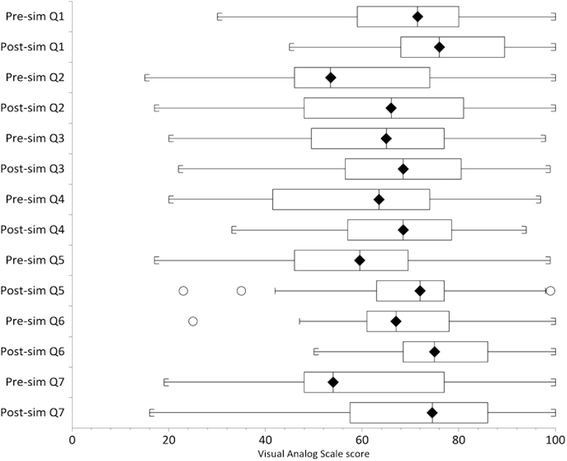Palliative care in the emergency department: an educational investigation and intervention
- PMID: 29514625
- PMCID: PMC5842635
- DOI: 10.1186/s12904-018-0293-5
Palliative care in the emergency department: an educational investigation and intervention
Abstract
Background: To investigate the value of a novel simulation-based palliative care educational intervention within an emergency medicine (EM) residency curriculum.
Methods: A palliative care scenario was designed and implemented in the simulation program at an urban academic emergency department (ED) with a 3-year EM residency program. EM residents attended one of eight high-fidelity simulation sessions, in groups of 5-6. A standardized participant portrayed the patient's family member. One resident from each session managed the scenario while the others observed. A 45-min debriefing session and small group discussion followed the scenario, facilitated by an EM simulation faculty member and a resident investigator. Best practices in palliative care were highlighted along with focused learner performance feedback. Participants completed an anonymous pre/post education intervention survey.
Results: Forty of 42 EM residents (95%) participated in the study. Confidence in implementing palliative care skills and perceived importance of palliative care improved after this educational intervention. Specifically, residents 1) felt EM physicians had an important role in palliative care, 2) had increased confidence in the ability to determine patient decision-making capacity, 3) had improved confidence in initiating palliative discussions/treatment, 4) believed palliative education was important in residency, and 5) felt simulation was an effective means to learn palliative care. Differences noted between PGY1 and PGY 3 training levels in survey responses disappeared post-intervention. Residents noted being most comfortable with delivering bad news and symptom management and least comfortable with disease prognostication. Residents reported time constraints and implementation logistics in the ED as the most challenging factors for palliative care initiation.
Conclusion: Our case-based simulation intervention was associated with an increase in both the perceived importance of ED palliative care and self-reported confidence in implementing palliative care skills. Time constraints and implementation logistics were rated as the most challenging factors for palliative care initiation in the ED.
Conflict of interest statement
Ethics approval and consent to participate
The study protocol was reviewed by the Carolinas HealthCare Institutional Review Board and deemed exempt as research involving anonymous educational surveys obtained as part of normal education practice.
Consent for publication
This manuscript does not contain any specific individual’s data.
Competing interests
The authors declare that they have no competing interests.
Publisher’s Note
Springer Nature remains neutral with regard to jurisdictional claims in published maps and institutional affiliations.
Figures
Similar articles
-
Little Patients, Big Tasks - A Pediatric Emergency Medicine Escape Room.J Educ Teach Emerg Med. 2023 Oct 31;8(4):SG1-SG19. doi: 10.21980/J89W70. eCollection 2023 Oct. J Educ Teach Emerg Med. 2023. PMID: 37969155 Free PMC article.
-
Management of Poisoned Patients: Implementing a Blended Toxicology Curriculum for Emergency Medicine Residents.J Educ Teach Emerg Med. 2022 Apr 15;7(2):C1-C32. doi: 10.21980/J8C937. eCollection 2022 Apr. J Educ Teach Emerg Med. 2022. PMID: 37465448 Free PMC article.
-
Palliative Care Education in Emergency Medicine Residency Training: A Survey of Program Directors, Associate Program Directors, and Assistant Program Directors.J Pain Symptom Manage. 2016 May;51(5):898-906. doi: 10.1016/j.jpainsymman.2015.12.334. Epub 2016 Mar 15. J Pain Symptom Manage. 2016. PMID: 26988848
-
Interactive Learning Module Improves Resident Knowledge of Risks of Ionizing Radiation Exposure From Medical Imaging.Curr Probl Diagn Radiol. 2016 Jul-Aug;45(4):258-64. doi: 10.1067/j.cpradiol.2015.11.002. Epub 2015 Nov 10. Curr Probl Diagn Radiol. 2016. PMID: 26657346 Review.
-
Research priorities for palliative and end-of-life care in the emergency setting.Acad Emerg Med. 2011 Jun;18(6):e70-6. doi: 10.1111/j.1553-2712.2011.01088.x. Acad Emerg Med. 2011. PMID: 21676052 Free PMC article.
Cited by
-
Attitude toward end-of-life care in emergency medicine residents- can a short workshop make a difference?PLoS One. 2023 Jan 11;18(1):e0280229. doi: 10.1371/journal.pone.0280229. eCollection 2023. PLoS One. 2023. PMID: 36630421 Free PMC article.
-
Evaluation of an Emergency Department-based Palliative Care Extender Program on Hospital and Patient Outcomes.West J Emerg Med. 2023 May 5;24(3):637-643. doi: 10.5811/westjem.56015. West J Emerg Med. 2023. PMID: 37278788 Free PMC article.
-
Current situation and effectiveness of palliative care training for staff in an emergency care medical consortium hospital: a cross-sectional study.Front Med (Lausanne). 2025 Mar 31;12:1480273. doi: 10.3389/fmed.2025.1480273. eCollection 2025. Front Med (Lausanne). 2025. PMID: 40231075 Free PMC article.
-
The Impact of Palliative and End-of-Life Care Educational Intervention in Emergency Departments in Singapore: An Interrupted Time Series Analysis.Medicina (Kaunas). 2025 Jan 21;61(2):173. doi: 10.3390/medicina61020173. Medicina (Kaunas). 2025. PMID: 40005291 Free PMC article.
-
Death in the Emergency Department: A Retrospective Analysis of Mortality in a Swiss University Hospital.Emerg Med Int. 2019 Sep 2;2019:5263521. doi: 10.1155/2019/5263521. eCollection 2019. Emerg Med Int. 2019. PMID: 31565438 Free PMC article.
References
-
- AAHPM. American Academy of Hospice and Palliative Medicine. (http://www.aahpm.org). Accessed 13 Jan 2016. - PubMed
-
- Cancer: WHO definition of palliative care. World Heath Organization. (www.who.int/cancer/palliative/definition/en/). Accessed 13 Jan 2016.
MeSH terms
LinkOut - more resources
Full Text Sources
Other Literature Sources
Medical
Research Materials


